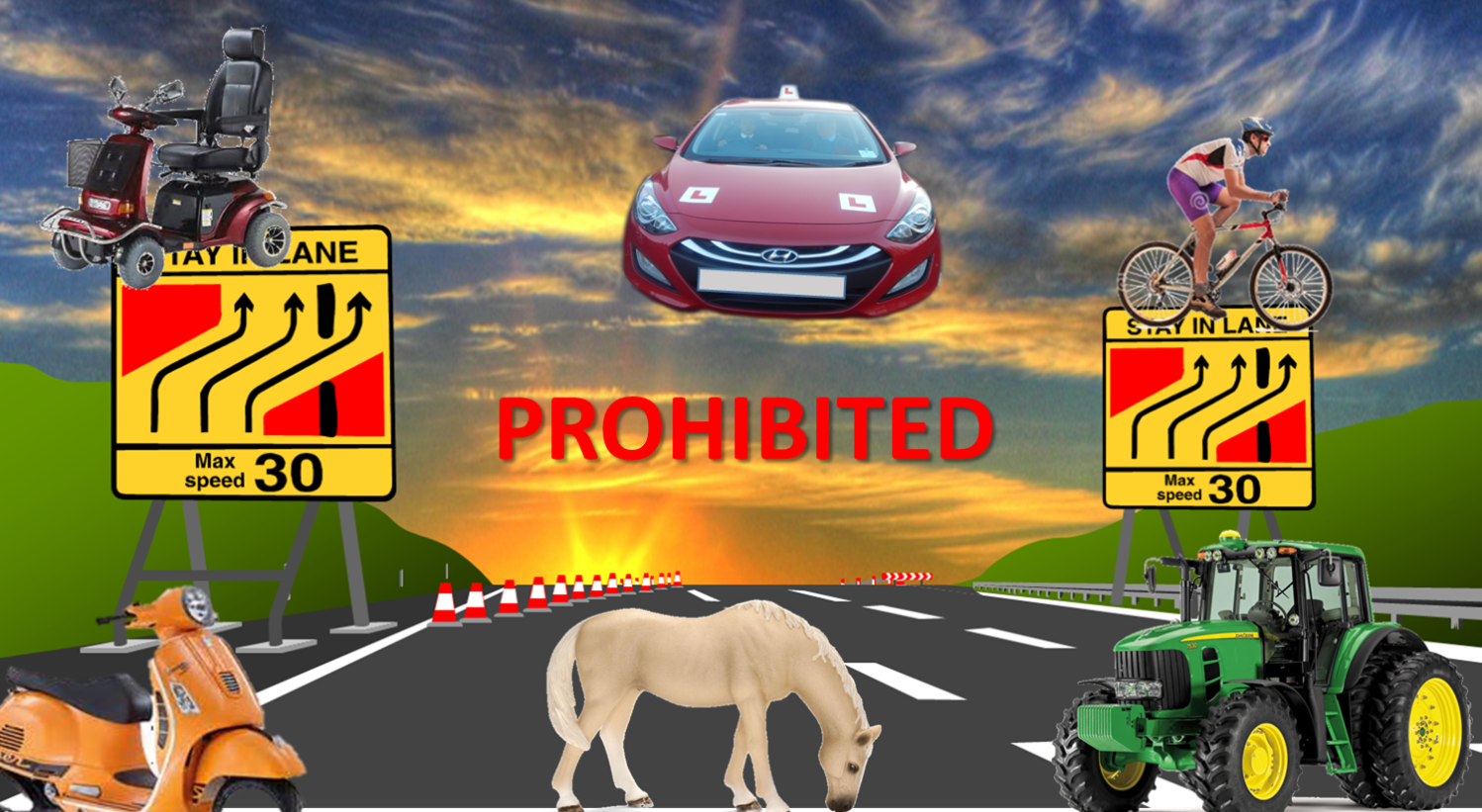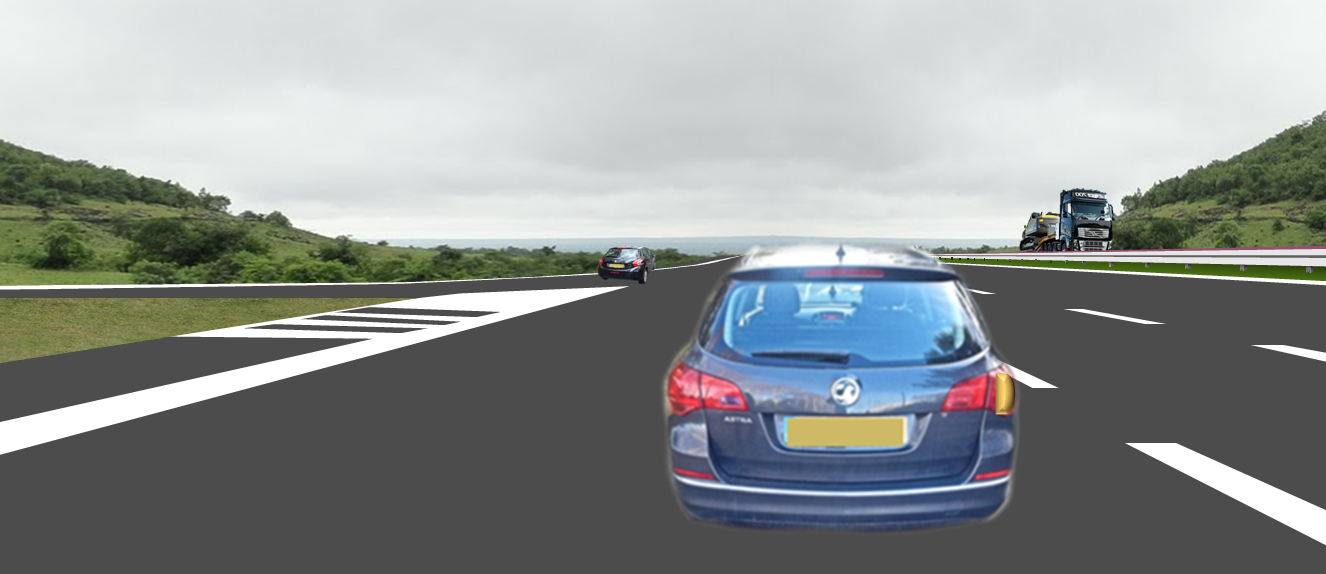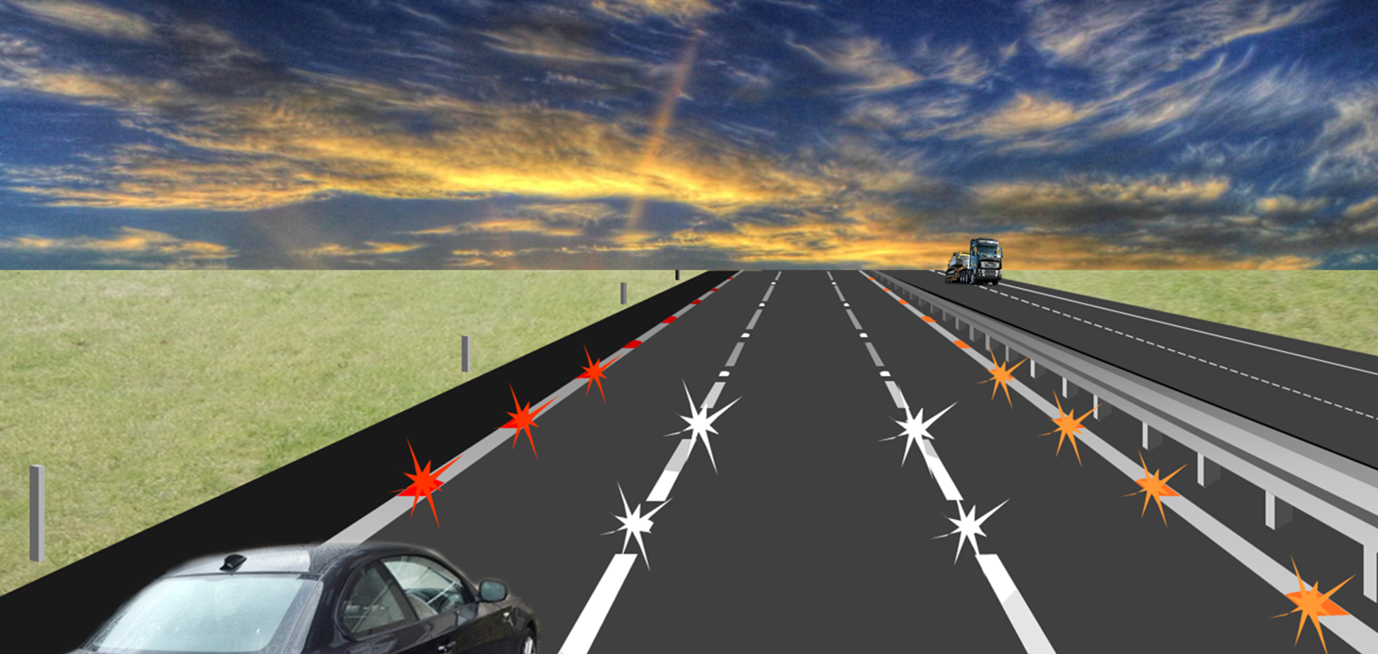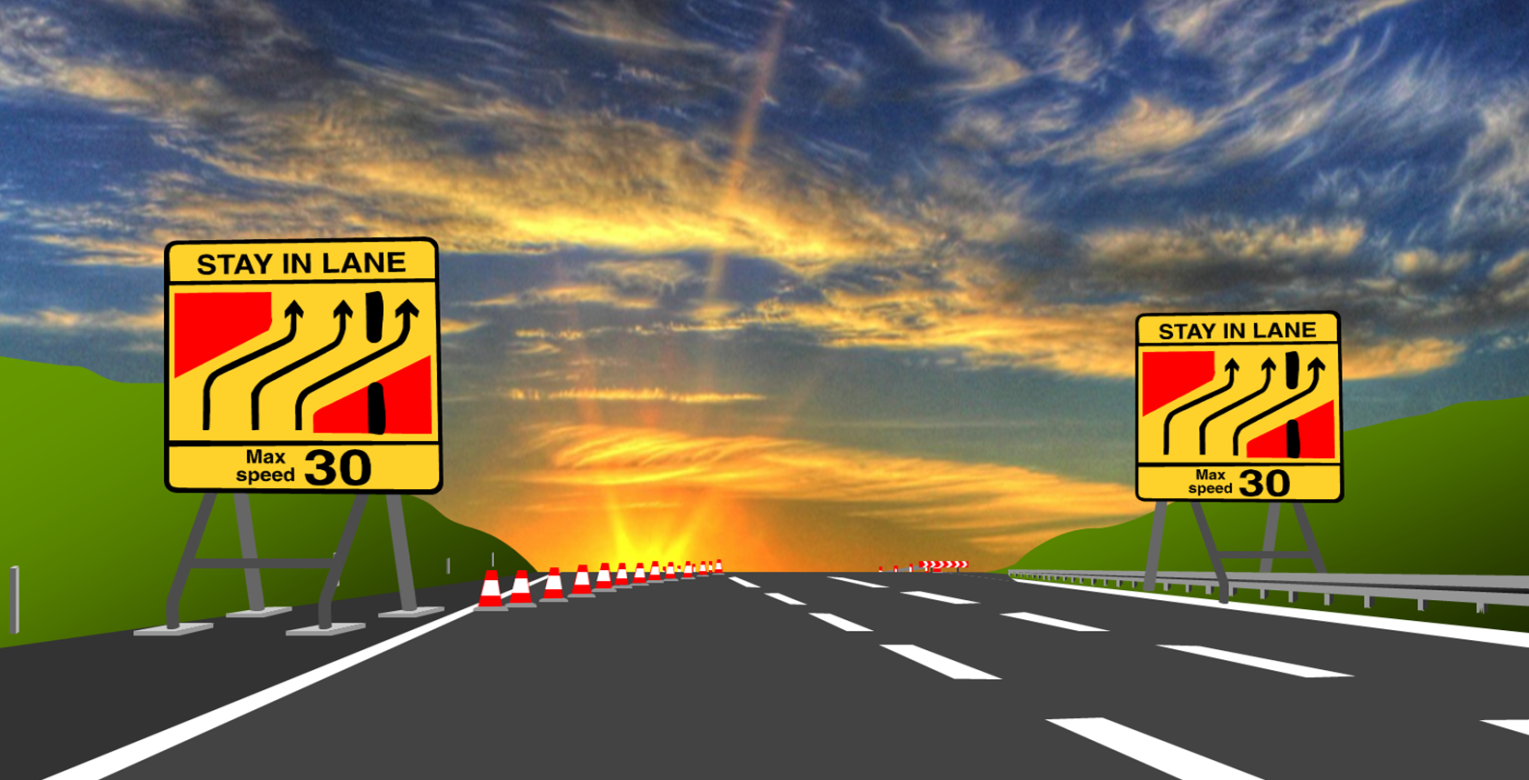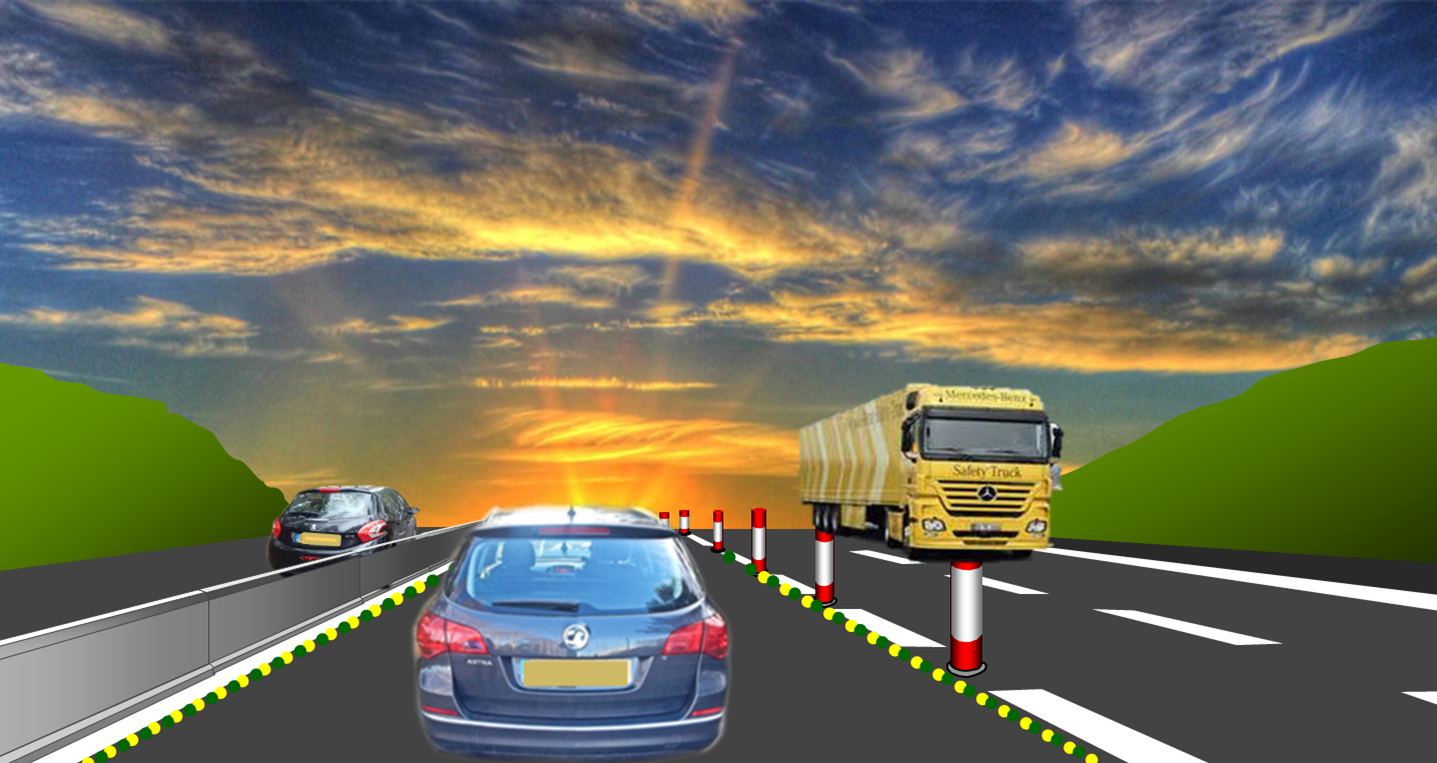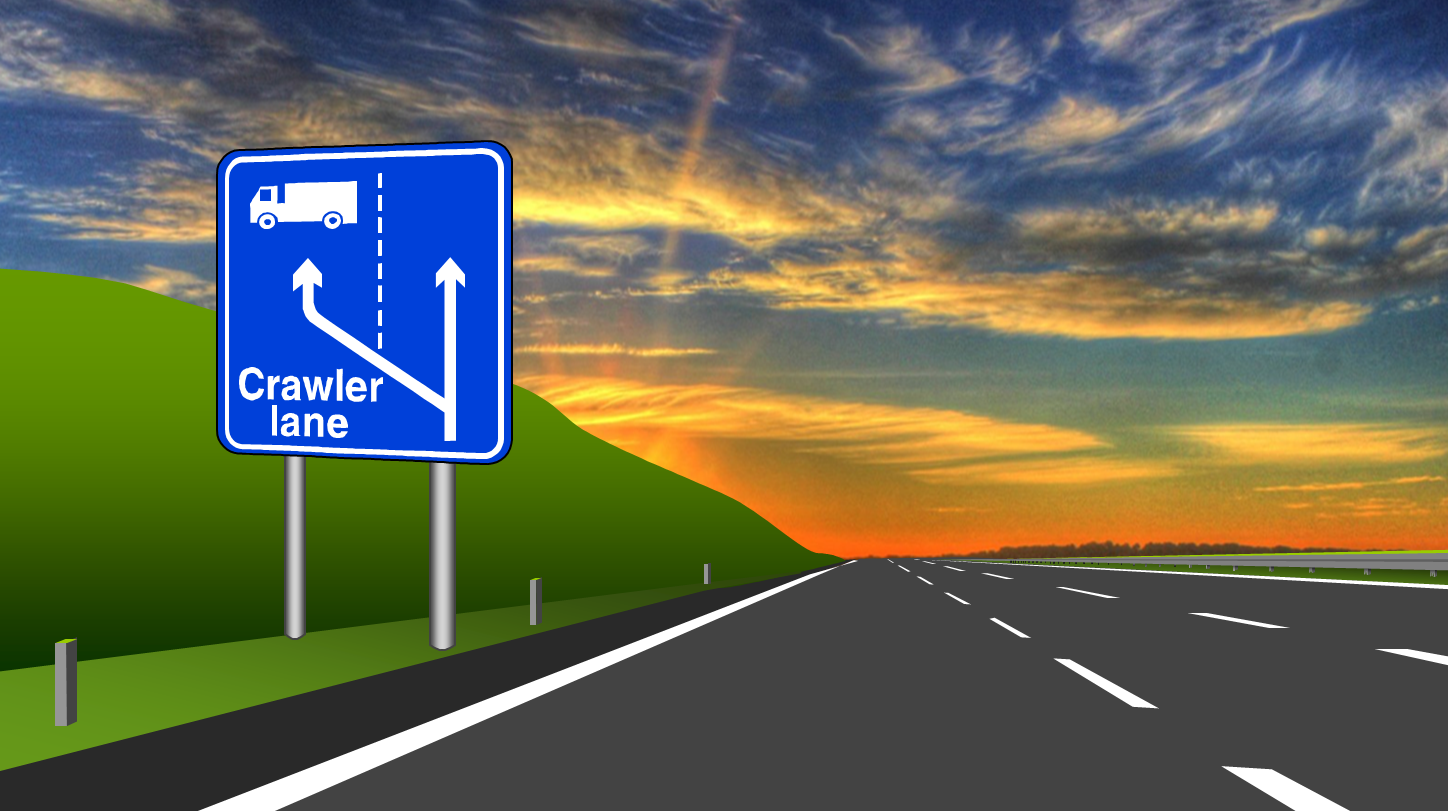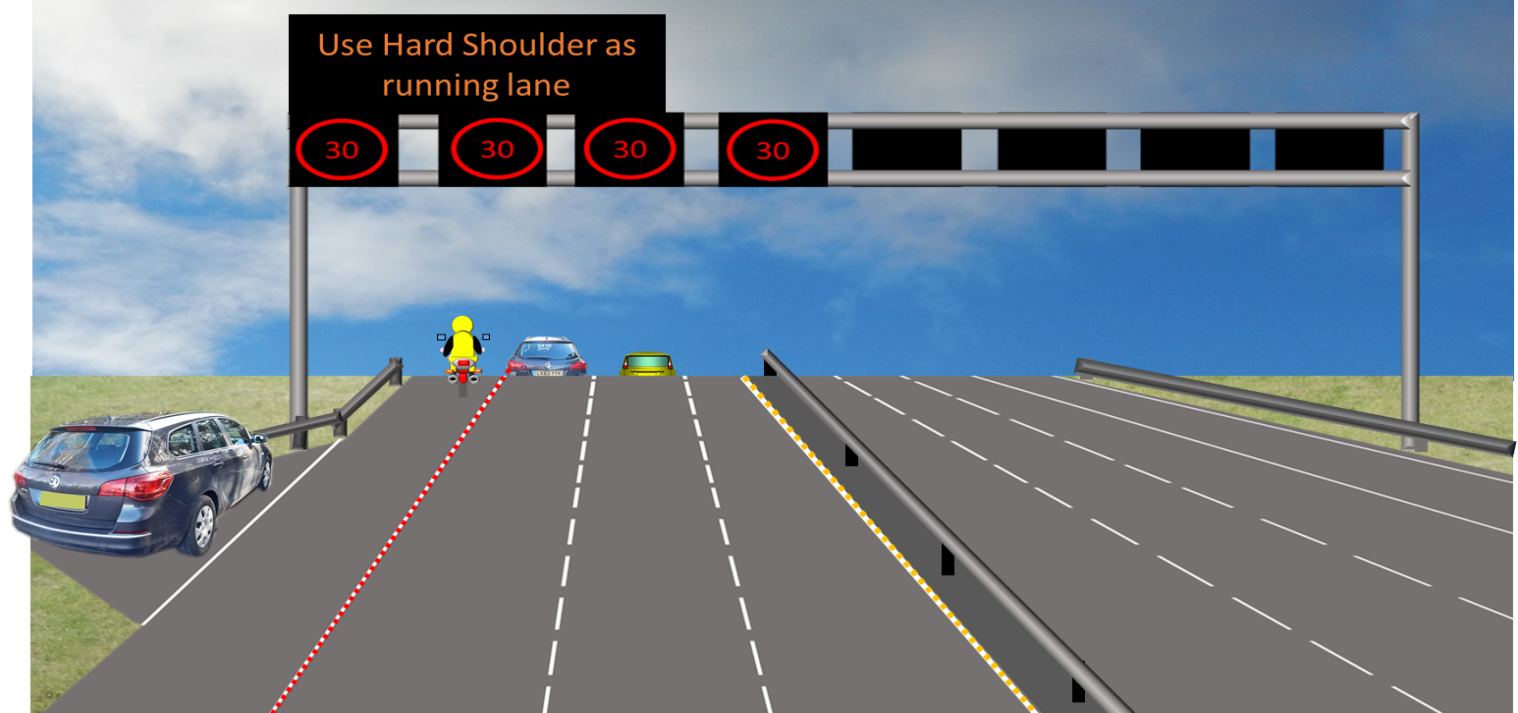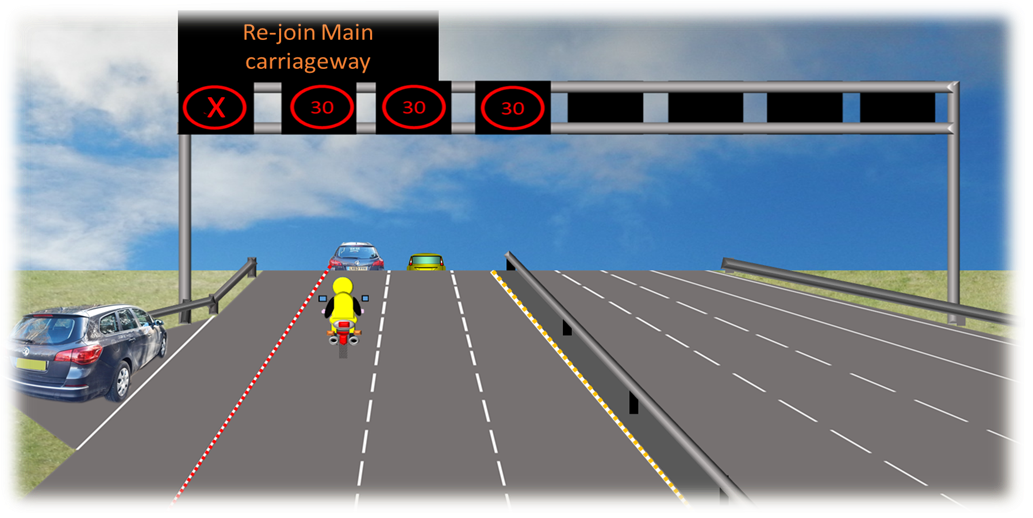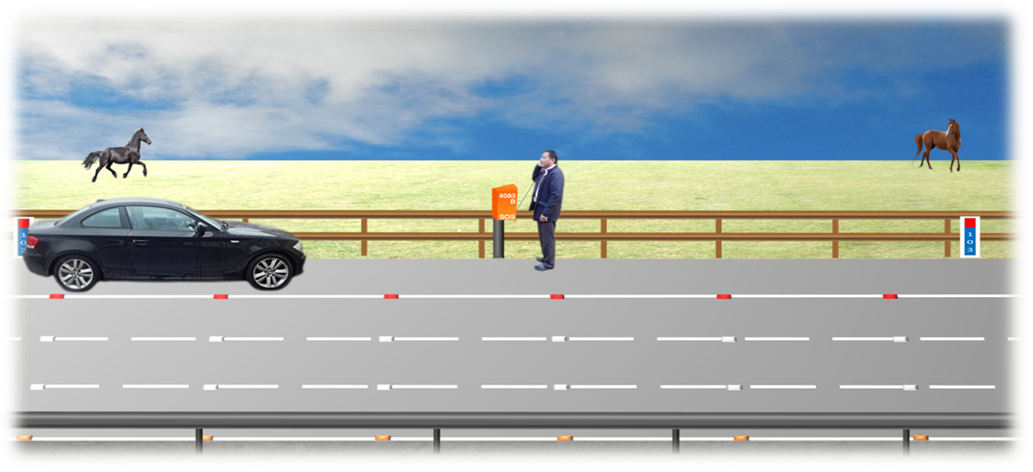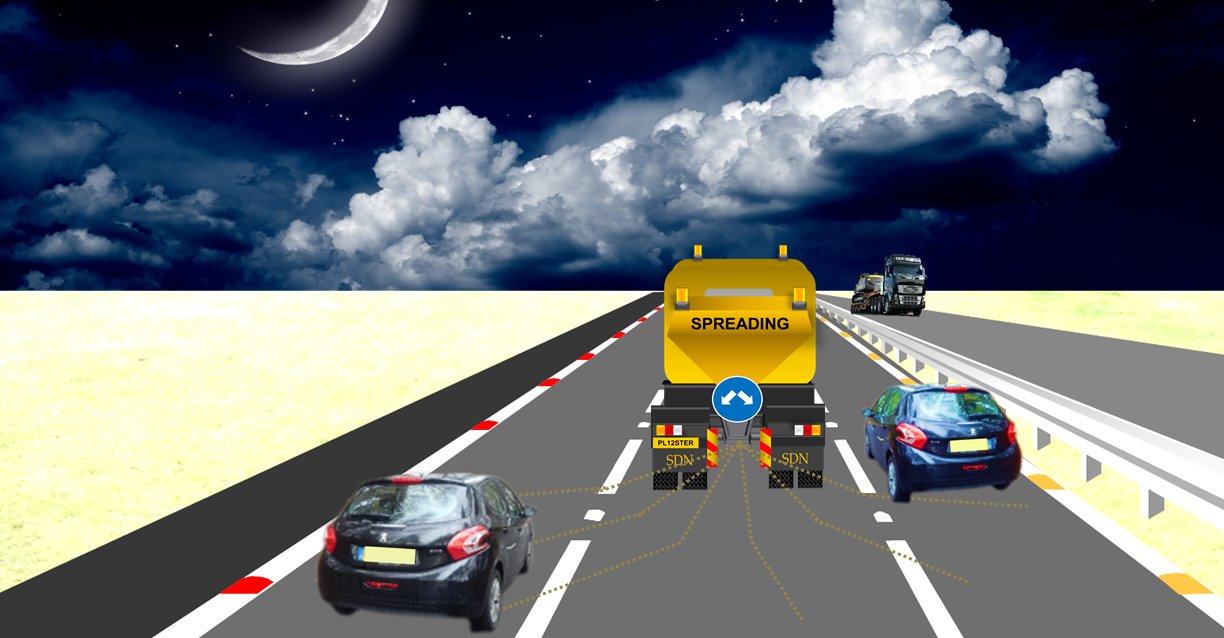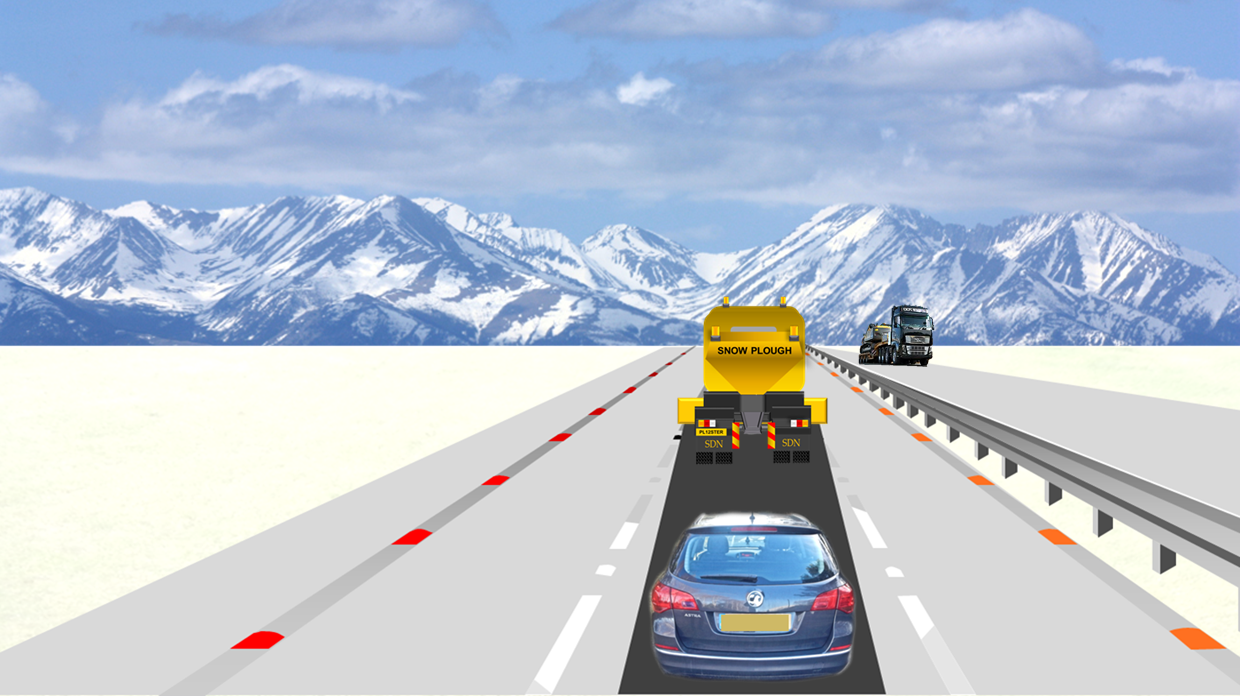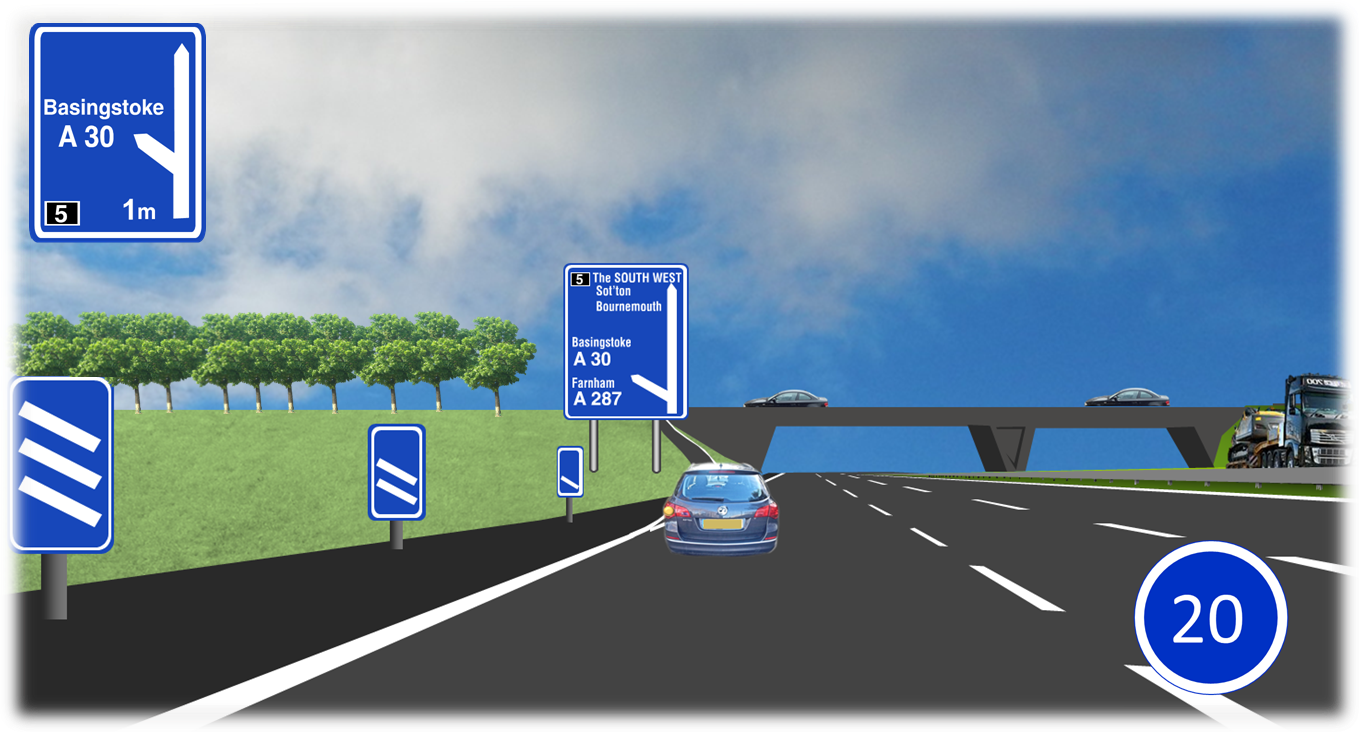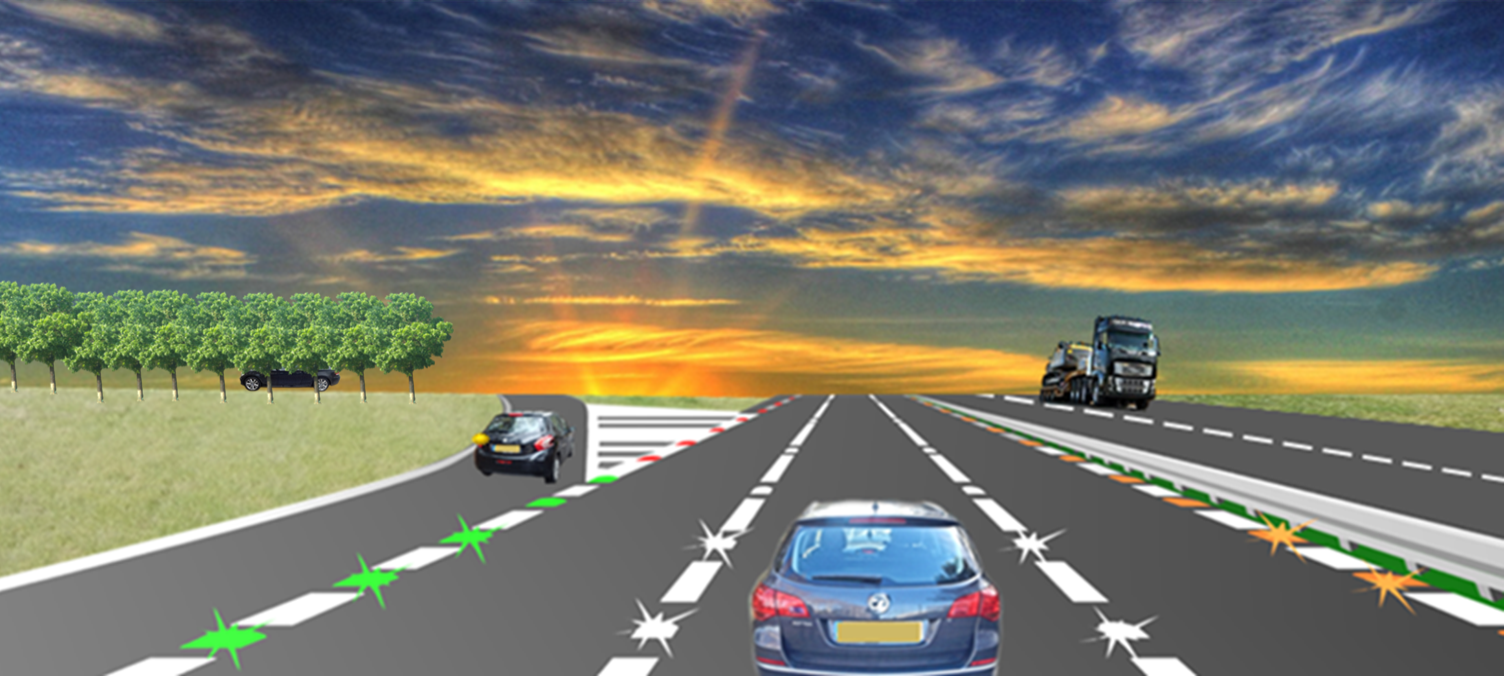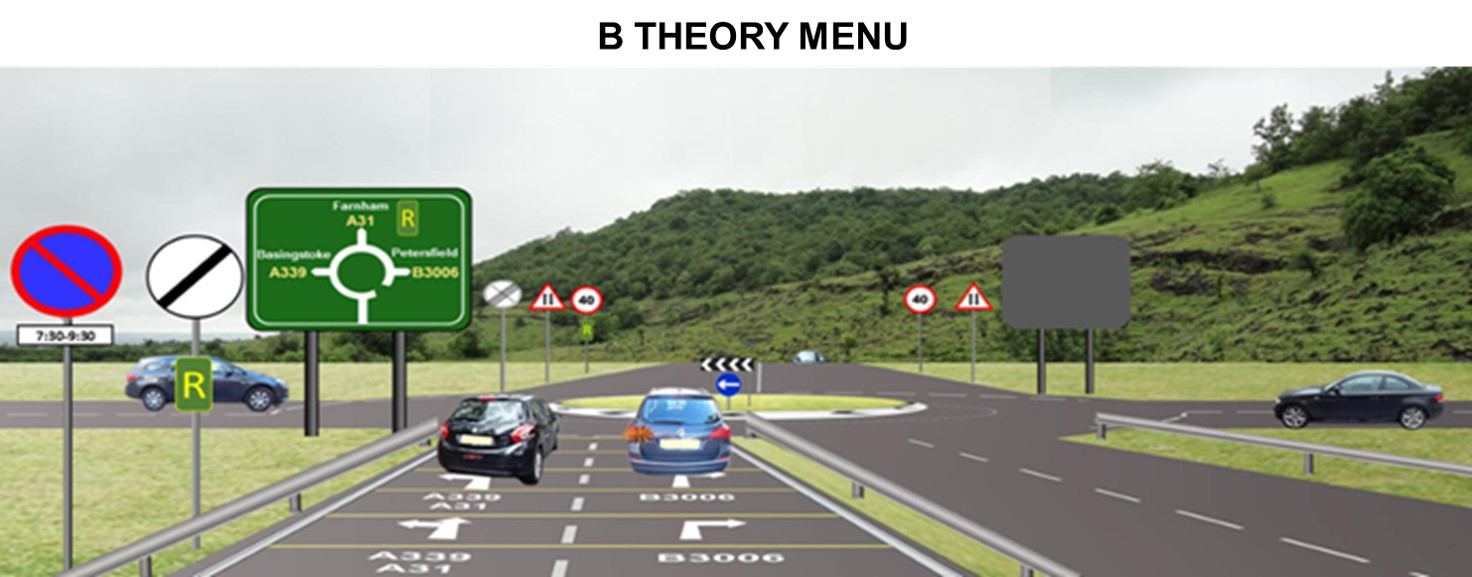MOTORWAYS
This section covers motorways and the procedures that must be carried out by you the driver.
Car learner drivers are prohibited from using the motorway. However learner car drivers can use motorways as part of their training syllabus as long as they are accompanied by a professional instructor. LGV learner drivers can use motorways, in some cases they can be part of the test route.
As we are dealing with today’s legislation, learner car drivers are banned, along with mopeds (under 50 cc), tractors, cyclists, horses and invalid carriages.
The most important thing to consider is that motorways are very busy and speed limits are set at 70 mph for cars and motorbikes and 60 mph for large goods vehicles and cars towing trailers.
On no account, should pedestrians use the carriageways and this includes the slip roads. If a pedestrian is identified by the police in such a situation they will be removed to a place of safety.
The regulations for motorways are different to the normal road network within the UK. Advice given to newly qualified drivers is that they obtain green ‘P’ plates to show other road users they have recently qualified. This will warn drivers to be more patient around you.
JOINING THE MOTORWAY
When merging onto a motorway, it is important to understand that vehicles already on the carriageway have right of way. You must keep giving a sideways glance when merging. It is for you to determine the speed at which the rest of the traffic is flowing. Adjust your speed to suit. Do not assume that other vehicles have seen you and be prepared to slow or, if necessary, use the hard shoulder to avoid a potential collision.
If you are on the main carriageway and see a vehicle that is due to merge onto the motorway, check your mirrors and, if safe, signal and move into the next lane.
The majority of motorways have three lanes plus a hard shoulder. The right-hand lane is guarded by a central barrier and the reflective studs are amber to warn you of this in poor lighting.
The centre lanes are marked by white reflective studs. The left-hand lane is marked by red studs. You must not cross the solid white line unless you need to enter the hard shoulder in an emergency.
Always drive in the left-hand lane and only use the middle and right hand lane for overtaking . Once you have overtaken move back to the left lane. The speed limits as stated before, is 70 mph for cars and motorbikes and 60 mph for large goods vehicles.
The motorway network is designed to get you to your destination as quickly and as safely as possible with least effect on the environment. However, because the motorway network is now dated, certain sections will have restrictions whilst under repair.
CONTRAFLOW
Contraflows are designed to keep traffic flowing in accordance with priorities. If required they can be set up to give three lanes of traffic in both directions. In some cases this means traffic will be driving against the flow (Contra). When you approach roadworks on a motorway, irrespective of how frustrating it can be you must allow other vehicles to merge in turn. Good drivers will get into the correct lane in good time. There are and always will be inconsiderate motorists that leave it till the last second. Be patient in this situation.
In the picture below you can see clearly that the right-hand lane moves to the other carriageway, once in that lane you will be driving against the natural flow of traffic.
The lanes are separated by red and white posts that are designed to separate opposite streams of traffic. They do not give a solid barrier. You will be restricted to lower speed limits.
As well as the reduced speed limits, you will also see yellow/green fluorescent cat’s eyes (cats eyes are illuminated at night by your vehicles dipped head lights).
If your vehicle breaks down in road works, you must stay with it until recovery arrives. If you break down on a motorway under normal conditions, you would get out of the vehicle and find safe refuge.
One important point to remember is that when approaching or driving through roadworks you will see work men. Be prepared to give way to them. They may need to cross the carriageway to erect temporary barriers.
GANTRY AND MATRIX SIGNS
Matrix signs can be seen every two miles along the centre reservation on the right of the carriageway. The information displayed on them is clear and easy to understand.
The signs keep the driver informed of any potential hazard they are approaching. The matrix signs inform you of all potential hazards ahead.
The 50-mph sign displayed is mandatory, the speed limit must be obeyed always. Remember it is a maximum speed limit.
On the matrix signs above, the fog sign is warning you of the risk of fog. It might appear to be clear but without warning you could suddenly find yourself in a fog bank with seriously reduced vision. On seeing this sign reduce your speed and, if you have not already done so, put on your dipped headlights if visibility drops below 100 metres.
The lane closed sign clearly tells you that the left-hand lane of this three-lane motorway is closed. You will always get plenty of warning allowing you to move to the next lane safely and in good time.
The curved arrow is telling you to leave the motorway at the next exit as the motorway ahead is closed. On seeing this sign, you can expect queuing traffic at the next junction as everyone will be trying to exit.
The end sign is informing you that all restrictions have ended and if safe to do so, resume normal motorway driving.
Gantry signs will display the same information as matrix signs. Gantry signs can be well distributed but can nearly always be found on approach to exits
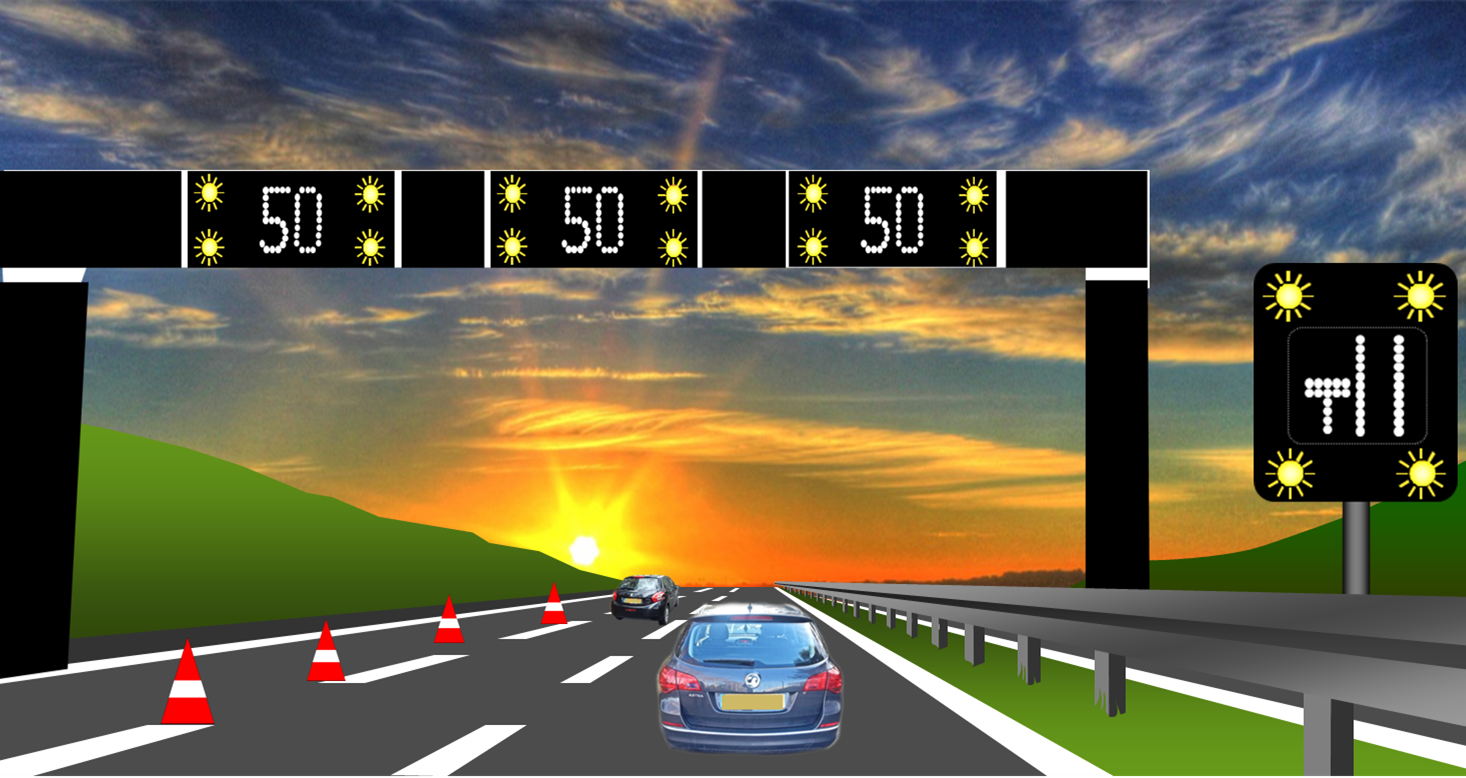 In picture below the gantry sign is telling traffic to stop in all lanes as the motorway has been closed due to the accident.
In picture below the gantry sign is telling traffic to stop in all lanes as the motorway has been closed due to the accident.
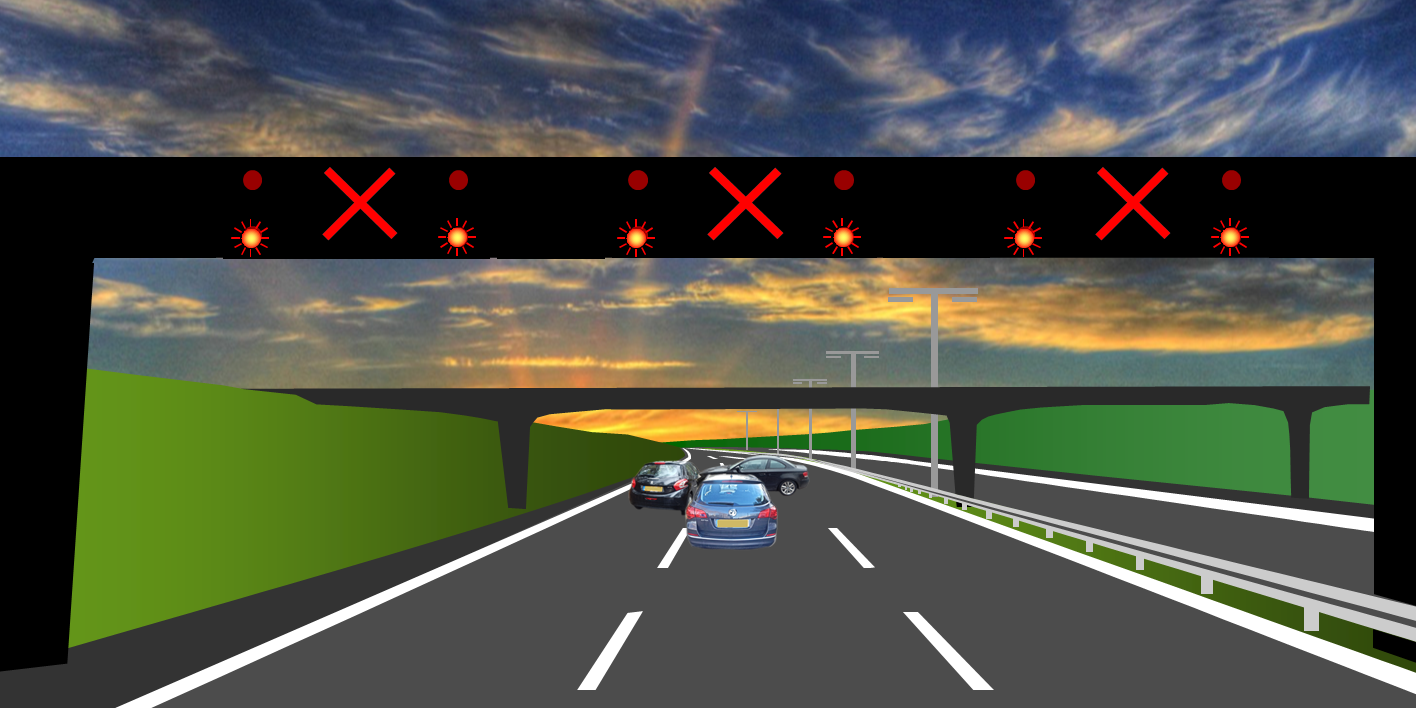 Check your rear-view mirror as the vehicles behind you might not anticipate your sudden reduction in speed.
Check your rear-view mirror as the vehicles behind you might not anticipate your sudden reduction in speed.
As an additional warning, you can switch on your hazard lights for a short period. This will show following traffic that you are reducing speed. The distance you travel before the traffic comes to a complete standstill will vary so stay alert, keep your distance from the vehicle ahead and always slow in good time.
CRAWLER LANES
On certain stretches of motorway an additional lane may be provided for slow moving vehicles. This lane is known as a crawler lane and can be found on long uphill gradients.
It allows slow moving vehicles to move to the left into the additional lane. This allows the motorway to become less congested from very slow moving vehicles.
At the end of the crawler lane there will be advanced warning signs informing slow vehicles to move back onto the main carriageway.
SMART MOTORWAYS
Active Management Systems or ‘Smart Motorways’ have been designed to keep traffic flowing. Variable mandatory speeds will be displayed on gantry signs.
Traffic coordinators monitor the motorway via cameras and regulate the speeds to keep traffic moving. Speed cameras can also be found on these gantries. These cameras may even be operating at normal speeds.
As on any road, exceeding the revised speed limits will result in penalty points and a fine.
When driving on a smart motorway you may find that the hard shoulder is to be used as a normal lane for driving. If you experience problems with your vehicle you will find refuge areas every 500 meters along the left hand side of the carriageway that you can use for safety.
When the traffic flow diminishes, the hard shoulder will be closed to normal traffic, you will be instructed to return to the main carriageway. If you continue to use the hard shoulder after this instruction you will be committing an offence.
The hard shoulder can only now be used for emergencies.
BREAKDOWNS
If you breakdown on a motorway look at the white, blue and red markers as they will guide you to the nearest SOS telephone. These phones have a number that when quoted will accurately give your position. You will be asked for your vehicle registration, your details and make of vehicle. More importantly you will be asked if you belong to a breakdown service. If you do not belong to a service, the recovery process will be very costly. When using the phones always face the traffic so that you can be prepared move if necessary.
Motorways can be very dangerous. Get everyone out of the vehicle to a safe place as there is a serious risk of a collision. Make sure that you turn your steering to the left, if another vehicle does strike your vehicle it will push it off the motorway and not onto the carriageway.
If you break down in roadworks stay in the vehicle, this is the safest option. Roadworks normally have reduced speed limit, they are monitored and recovery will be with you promptly. Do not worry about belonging to a breakdown service, recovery from roadworks is free, but only to the nearest safe haven.
•Do not attempt to change a tyre or carry out maintenance to your vehicle.
•Do not display a warning triangle.
•The hard shoulder is to be used for emergencies only
The police will be notified of your position and will attend, parking behind your vehicle. They will display blue flashing beacons, warning other traffic of your broken down vehicle. Traffic officers from the Highways agency could also attend.
They will display red and amber flashing beacons to warn traffic of the danger.
When your vehicle has been repaired don’t just pull out on to the main carriageway. Use
the hard shoulder to build up your speed and join smoothly without causing other
vehicles to slow down or swerve to avoid you.
When driving along the motorway be aware of other drivers that are broken down on
the hard shoulder. If you see a vehicle displaying a HELP pennant (Sign), advice the authorities when safe, the sign is indicating that the vehicle belongs to a disabled person who probably needs help but is unable to get out of the vehicle to phone for assistance.
INCLEMENT WEATHER
When driving on the motorways in the winter months you must be cautious as the unexpected can happen. Make sure that you keep up to date with the weather forecast. You must seriously consider allowing more time for your journey and plan your route wisely.
The picture above shows a typical example of the motorway surface being gritted. The grit is rock salt and will help to stop ice forming on the road surface. Generally the gritter will use the middle lane and will display on the rear an instructional sign which tells you which side you can pass it safely.
In this instance you may pass on either side. Be prepared for the salt bouncing off the road surface and hitting your vehicle – this will not cause any damage but the sudden sound may startle you. In the event of snowfall, you must obey all mandatory speed limits. Remember it will take you up to ten times the distance to stop so increase your distance from the vehicle in front.
Do not try to overtake a snowplough as you might drive into deeper snow. Depending on the severity of the conditions stay behind it and be patient. Make sure you have additional equipment with you.
It is advised to carry a shovel, blankets, flask, food and snow chains. Be prepared as you may end up stranded for hours in extreme weather conditions. The exits on a motorway can be a long distance from you.
You cannot stop in the hard shoulder to fit snow chains, even in inclement weather the hard shoulder is still only for emergencies.
LEAVING THE MOTORWAY
If you have planned your route you will almost certainly know the junction number you require. The picture shows the junction number 5 in the bottom left hand corner of the sign.
The first indication of this number can be seen on the 1 mile sign. You will get another junction sign at the half mile marker, it will display additional destinations and the junction number. As you approach the exit there will be blue and white countdown marker indicating the 300, 200 and 100 metres (270 / 180 / 90 yards) giving you sufficient warning to be prepared to exit if necessary.
Do not leave it until the last minute to get into the correct lane.
On preparing to leave you could possibly see a minimum speed limit on the slip road. Unless there is an obstruction, your speed must not go below the speed indicated. The sign is shown in the bottom right hand corner of the picture displaying 20.
On all entry and exit slip roads the cats eye reflective markers will change to green. As in the traffic light sequence green means you can cross the white line.
You will get advanced warning that you are coming to the end of the motorway, followed by a sign telling you that motorway regulations have stopped. You must now obey the regulations for the new roads.



